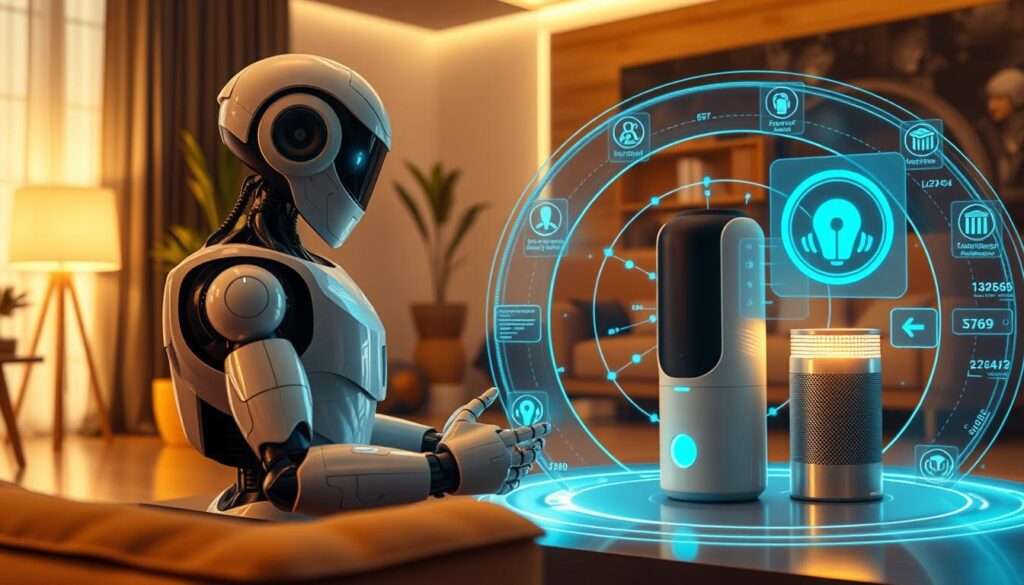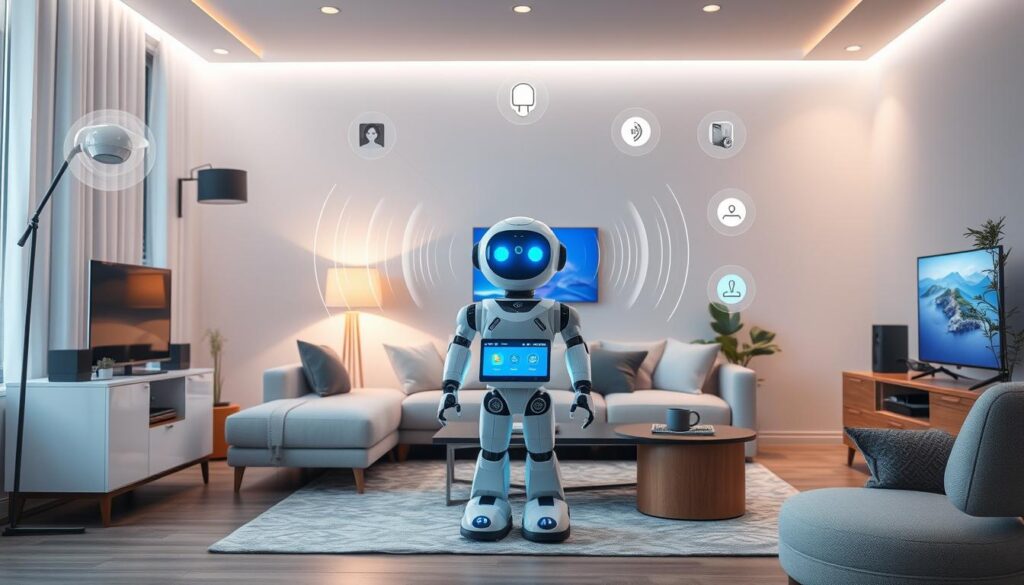The home robotics industry is growing fast. Voice recognition systems play a big role in making these robots better. By 2030, 80% of us will talk to smart robots every day, up from less than 10% now. This change is thanks to smarter robots that can understand and help us more.
For home robots to be easier to use, they need to understand our voices well. They use special tech to listen and talk back in a way that feels natural. This tech lets robots have real conversations with us, making our interactions more fun and useful.
Adding voice recognition to home robots makes them more helpful and friendly. They can even be good friends in places like hospitals, helping patients feel better. These robots are also helping in many other areas, like food delivery and healthcare, making things better and more efficient.
The Rise of Service Robots
The global robotics market is growing fast, valued at around $27.7 billion in 2020. It’s expected to hit $74.1 billion by 2026. Service robots are leading this growth, changing healthcare, logistics, and hospitality.
The Role of Speech AI in Service Robots
Service robots need advanced speech AI to talk like humans. Automatic speech recognition and text-to-speech are key. They let robots understand and speak back, making interactions smooth.
Asian companies lead the service robotics market, making over a third of the global revenue. China is a key player, adding over 268,000 industrial robots in 2021 alone.
Service robots are growing fast due to staff shortages and the need for contactless services. They include delivery, hospitality, and cleaning robots. These robots aim to make things more efficient, safe, and user-friendly.
| Service Robot Application | Key Features | Market Potential |
|---|---|---|
| Delivery Robots | Contactless delivery, autonomous navigation | Projected growth to 1.3 million Robots-as-a-Service (RaaS) installations by 2026, generating $34 billion in revenue |
| Hospitality Robots | Guest experience enhancement, human-like interaction | Widespread adoption in hotels and restaurants, with companies like Yotel and Henn-na Hotel in Japan leading the way |
| Cleaning Robots | Automated cleaning, reduced human labor, chemical exposure mitigation | Significant growth in healthcare and other industries, with companies like Xenex and Brain Corp providing advanced solutions |
As the service robotics market grows, speech AI will be key. It will help robots talk to humans better, leading to more use and progress in these technologies.
Accent and Dialect Recognition
As voice control tech gets better, recognizing different accents and dialects is key. Accent recognition means a system can understand unique ways of speaking from various places or groups. This is vital for making voice control systems more responsive and user-friendly for everyone.
Dialect recognition deals with the unique ways people speak the same language. These differences, shaped by where someone is from, their social group, or culture, affect how well systems understand speech. By recognizing these dialects, voice control tech can better understand and respond to users, making their experience better.
How well a speech system works is measured by its accuracy. Error rates show how often it makes mistakes. Creating a model of sound interactions, or acoustic modeling, is crucial. It helps systems work better, even when there’s background noise.
| Metric | Description | Relevance |
|---|---|---|
| Speech Recognition Accuracy | The degree to which a system’s output matches the expected or true values. | Crucial for ensuring reliable and user-friendly voice control interactions. |
| Error Rates | The frequency of mistakes made by the speech recognition system. | Indicates the system’s reliability and the need for ongoing improvements. |
| Acoustic Modeling | The process of creating a mathematical representation of sound wave interactions. | Essential for enhancing the accuracy and efficiency of speech recognition, especially in the presence of background noise. |
By recognizing accents and dialects, speech systems can meet the varied needs of users. This makes voice control with home robots more effective and enjoyable for everyone.
Home Robot Development
The world is moving towards smart homes, and home robots are leading the way. These robots make our lives easier by handling tasks for us. They understand voice commands and give us feedback, changing how we live.
Command Execution and Feedback Mechanisms
Home robots work by understanding and acting on our commands. They use sensors, cameras, and AI to get what we want. This makes them very good at doing tasks for us.
They also give us feedback to make our lives better. This feedback helps them adjust to our needs. It makes them better at moving around, picking up things, and more.
Thanks to robotics engineering and autonomous systems, home robots can do a lot. They can clean, watch over our homes, and even entertain us. This makes our homes more efficient and safe.
As home robots get better, we’ll see even more cool things. They’ll be able to control things better and move around our homes easily. This will make our lives even more convenient and enjoyable.
Advancements in Conversational AI
Conversational AI has seen big changes lately. These changes have made talking to machines feel more natural. This is thanks to better natural language processing, deep learning, and dialogue management.
Deep learning has been key in making Conversational AI better. It uses neural networks to understand and respond to human language. This has made speech recognition and dialogue generation much more accurate.
Dialogue management has also improved a lot. Now, conversations between humans and machines are more coherent and relevant. This makes talking to machines feel more like talking to another person.
Conversational AI is getting even better with new tech like multimodal interaction and emotion recognition. These systems can understand speech, gestures, and facial expressions. This makes interactions more natural and intuitive.
Conversational AI has many uses, like in home robots, customer service, and healthcare. These advancements make talking to machines easier and more efficient. They also open up new ways for humans and machines to work together.

But, there are also big questions about ethics in Conversational AI. We need to make sure data is private and address risks. We also need to think about how these changes might affect jobs.
In summary, Conversational AI has changed how we talk to machines. It’s making interactions more natural and personalized. As it keeps getting better, it will change many industries and improve our lives.
Emotion Recognition in Speech
In the world of voice-controlled systems and home robots, recognizing and responding to human emotions is a big deal. This technology can tell how a person feels by listening to their voice. It looks at things like tone, pitch, and rhythm. This helps make the system more personal and responsive to the user’s mood.
Multimodal interaction systems use speech, gestures, touch, and visuals to communicate. They make talking to machines feel more natural and easy. This way, users get a better experience that meets their needs.
Scientists have made big progress in creating models that can really understand emotions. A recent study showed a model that could spot emotions with an F1 value of 0.931. It also found that using voice samples made the model more accurate than other methods.
For service robots, knowing how to read emotions is key. These robots are set to help us in many ways, like in healthcare and helping the elderly. By understanding and reacting to our feelings, they can offer better services and improve our lives.
Thanks to natural language processing and machine learning, emotion recognition is getting better. Researchers have tried different methods to improve accuracy. As we keep working on making robots and machines more human-like, understanding emotions will be essential.
| Metric | Value |
|---|---|
| Sentiment Analysis Model F1 Value | 0.931 |
| Improvement in Accuracy using Voice Samples | Compared to fixed-length processing methods |
| Key Capabilities of Service Robots |
|
| Importance of Emotion Recognition in Speech | Crucial for improving human-robot interaction |
Multimodal Interaction and Integration
Multimodal interaction systems are changing how we interact with robots. They let us use speech, gestures, touch, and visuals to talk to robots. This makes using technology feel more natural and easy.
These systems have made robots work better with us. Robots can now work together smoothly. This makes them more efficient and easier to use, especially when they use many ways to communicate.
- The intention recognition rate in the experiments was 93.62%.
- The impacts of short-term and long-term changes were considered during the development of the multimodal domestic service robot interaction system.
- Five independent modalities were used in the service robot interaction system: touch, voice, myoelectricity gesture, visual gesture, and haptics.
Service robots do many things, like watching over us and helping with chores. Smart homes make these robots even more useful. They help people who need extra help.

There are many ways to interact with robots, like using screens, talking, and gestures. Scientists are working on making these interactions better. They want to make it easier for us to talk to robots.
The global market for multimodal AI is growing fast. It’s expected to reach $10.55 billion by 2031. This shows how much potential there is in making robots and technology work together better.
Conclusion
Voice recognition and speech AI have changed how we talk to home robots. Now, we can give commands naturally and get personalized answers. This makes controlling home robots easy and hands-free.
These technologies, along with conversational AI, emotion recognition, and multimodal interaction, are key. They help home robots fit smoothly into our daily lives. They can handle many tasks and meet our needs.
The home robot industry is growing fast. Soon, robots will be smarter, more responsive, and easier to use. Thanks to Large X Models, robots will get better at many things. They will work more efficiently and adapt to new situations.
Robot vacuums are now affordable and reliable, making home robots more accessible. In the next decade, robots might automate up to 40% of household chores. This means our homes could become more efficient and less cluttered.

